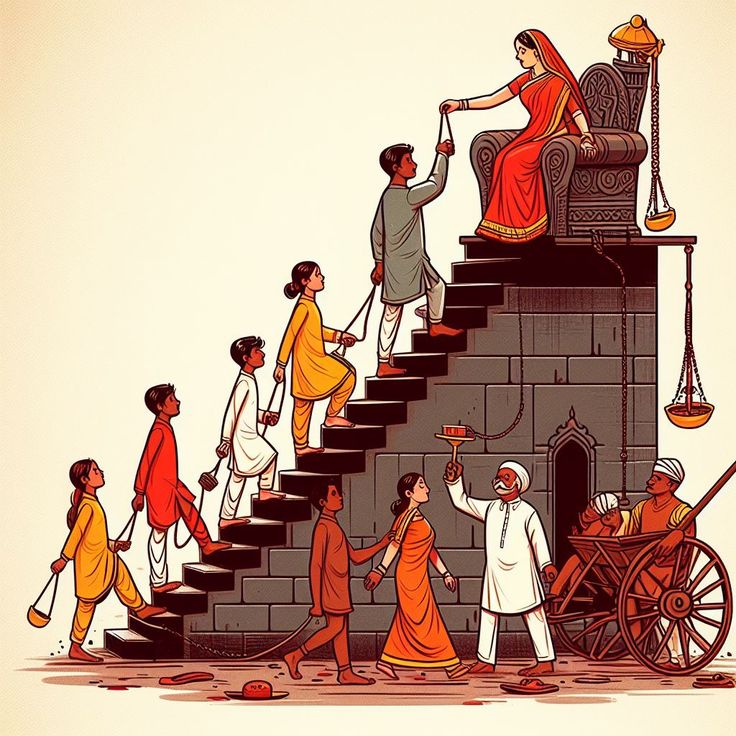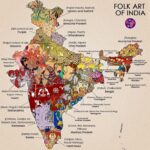Indian Caste System: History, Impacts, and Significance in Society
Indian Caste: The Indian caste system is one of the oldest social hierarchies in the world, deeply embedded in the history, culture, and structure of Indian society. While it has undergone significant transformations over the centuries, its influence on everyday life remains profound, especially in rural areas and certain communities. In this article, we explore the history, impacts, and significance of the caste system in India, its social consequences, and its evolving role in contemporary society.
History of the Indian Caste System
The caste system, known as Varna in ancient texts, originated in the Vedic period around 1500 BCE. According to the Rigveda, society was divided into four main categories or Varnas: Brahmins (priests and scholars), Kshatriyas (warriors and rulers), Vaishyas (traders and agriculturists), and Shudras (laborers). This division was initially based on the roles that individuals played in society.
Over time, these four Varnas became more rigid, and the concept of jatis (sub-castes) emerged. The system became more complex, with thousands of jatis based on factors like region, profession, and lineage. The caste system, especially the lower classes or the Dalits (previously known as “Untouchables”), faced severe discrimination and social exclusion, leading to a long history of marginalization.
During British colonial rule, the caste system became further entrenched, as the British relied on it for administrative purposes and categorized people for taxation and other policies. However, post-independence, India made significant efforts to eradicate caste-based discrimination through legal and social reforms.
The caste system in India is a complex social hierarchy that has historically divided society into groups based on occupation, birth, and social status. While the Indian Constitution has abolished caste-based discrimination and untouchability, the system still influences social dynamics in many parts of the country. Below is an overview of the traditional varna system and major caste groups in India:
Traditional Varna System
The varna system is a theoretical framework from ancient Hindu texts that divides society into four broad categories:
- Brahmins – Priests, scholars, and teachers.
- Kshatriyas – Warriors, rulers, and administrators.
- Vaishyas – Merchants, traders, and farmers.
- Shudras – Laborers and service providers.
Outside this system were the Dalits (formerly called “Untouchables”), who were historically marginalized and assigned the most menial tasks.
Modern Caste Groups
Over time, the varna system evolved into thousands of jatis (sub-castes), which are more localized and occupation-based. Below is a general categorization of caste groups in modern India:
1. Forward Castes (General Category)
- These include the upper castes, such as Brahmins, Rajputs, and other dominant groups.
- Examples:
- Brahmins (e.g., Gaur Brahmins, Saraswat Brahmins, Tamil Brahmins).
- Kshatriyas (e.g., Rajputs, Marathas, Jats, Gujjars).
- Vaishyas (e.g., Banias, Marwaris, Chettiars).
2. Other Backward Classes (OBCs)
- OBCs are socially and educationally disadvantaged groups that are not part of the upper castes but are also not considered Scheduled Castes or Scheduled Tribes.
- Examples:
- Yadavs (primarily in North India).
- Kurmis (in Bihar, Uttar Pradesh).
- Vanniyars (in Tamil Nadu).
- Lodhis (in Madhya Pradesh, Uttar Pradesh).
- Gowdas (in Karnataka).
3. Scheduled Castes (SCs)
- SCs, formerly known as “Untouchables” or Dalits, are among the most marginalized communities in India.
- Examples:
- Chamar (traditionally associated with leatherwork).
- Mahar (primarily in Maharashtra).
- Pasi (in Uttar Pradesh).
- Madiga (in Telangana and Andhra Pradesh).
- Pulayar (in Kerala).
4. Scheduled Tribes (STs)
- STs are indigenous tribal communities that often live in remote or forested areas.
- Examples:
- Gonds (in Central India).
- Bhils (in Rajasthan, Gujarat, Madhya Pradesh).
- Santhals (in Jharkhand, West Bengal, Odisha).
- Mundas (in Jharkhand).
- Nagas (in Nagaland).
5. Other Groups
- Sikh Castes: Jat Sikhs, Ramgarhias, Mazhabis.
- Muslim Castes: Ashrafs, Ajlafs, Arzals (though Islam rejects caste, caste-like structures exist among Indian Muslims).
- Christian Castes: Syrian Christians, Dalit Christians.
Caste-Based Reservations
The Indian government provides reservations (affirmative action) in education, jobs, and politics for Scheduled Castes (SCs), Scheduled Tribes (STs), and Other Backward Classes (OBCs) to address historical inequalities.
Key Facts
- The caste system is most prevalent in Hindu society, but it also influences other religious communities in India.
- Inter-caste marriages are becoming more common, but caste-based discrimination still persists in many areas.
- The Constitution of India prohibits caste-based discrimination and untouchability under Article 17.
Biography of Key Figures in the Fight Against Caste Discrimination
- Dr. B.R. Ambedkar
Dr. Ambedkar, one of the most prominent social reformers and the principal architect of the Indian Constitution, dedicated his life to the upliftment of the Dalits and fought against caste-based discrimination. He converted to Buddhism in 1956, encouraging millions of Dalits to follow suit, symbolizing his resistance to the rigid caste system. His work laid the foundation for India’s modern laws prohibiting untouchability and caste-based discrimination. - Mahatma Gandhi
Gandhi, known for his non-violent approach to resistance, also advocated for the abolition of untouchability. He called the Dalits Harijans (children of God) and pushed for their integration into society, advocating for social reforms to elevate their status and ensure equal rights. - Periyar E.V. Ramasamy
Periyar was a social activist and founder of the Self-Respect Movement in Tamil Nadu. He focused on the eradication of the caste system and promoted social justice, women’s rights, and the rejection of Hindu orthodoxy. His work significantly influenced the anti-caste movements in southern India.
Daily Life Impact of the Caste System; Indian Caste
The caste system has a significant impact on the daily lives of many people, particularly in rural areas. While the Constitution of India (1950) outlawed discrimination based on caste, its social ramifications continue to affect various facets of life.
Social Segregation: In some communities, social interactions are still influenced by caste, with people living in caste-based settlements or colonies. Marriage within one’s caste remains a common practice, and there are instances where caste-based restrictions on dining and religious practices persist.
Economic Opportunities: Caste often determines the type of work a person does. The lower castes, particularly the Dalits, were historically relegated to menial and unskilled labor, such as cleaning, leatherwork, or manual scavenging. Although there have been substantial improvements, economic disparities based on caste still exist, and individuals from lower castes often have limited access to education and employment opportunities.
Access to Resources: In rural areas, caste plays a role in determining access to resources like land, water, and credit. Upper-caste individuals often hold power over resources, while lower-caste individuals face barriers in acquiring or managing land.
The Significance of the Caste System in Modern India; Indian Caste
Despite legal measures to dismantle caste-based discrimination, the caste system’s legacy continues to shape modern Indian society. One of the most significant impacts is the ongoing quest for social justice. The Indian government has implemented affirmative action policies, such as reservations (quotas) in education, jobs, and legislatures, to uplift the Dalits, Tribals, and other backward classes. These measures, though controversial to some, aim to bridge the socio-economic divide created by centuries of caste-based discrimination.
Empowerment Through Education: In urban areas, the caste system is gradually losing its influence, particularly among the educated youth. Higher education and greater economic mobility are allowing individuals to break the barriers of caste and choose careers based on their interests and capabilities rather than their caste background.
Political Power: In Indian politics, caste plays a significant role. Caste-based political parties, particularly in states like Uttar Pradesh, Bihar, and Tamil Nadu, have emerged to represent the interests of specific caste groups. These parties advocate for the welfare of marginalized communities and often play a key role in regional and national politics.
Facts About the Caste System; Indian Caste
- Reservation System: In India, there is a system of affirmative action known as “reservation” for Scheduled Castes (SC), Scheduled Tribes (ST), and Other Backward Classes (OBC). These categories receive a certain percentage of seats in educational institutions, government jobs, and political representation.
- Rural vs Urban Divide: While caste-based discrimination is still prevalent in rural areas, urban India, with its cosmopolitan culture and greater economic opportunities, sees less of a caste divide in daily life.
- Global Migration: The Indian diaspora has spread across the world, and in many places, people are moving beyond caste identities. However, caste-based social groups still exist in some expatriate communities.
FAQs About the Caste System; Indian Caste
1. Is the caste system still prevalent in India?
While the caste system is officially abolished in India, its social and economic effects continue to be felt, particularly in rural areas and in certain communities.
2. How has the Indian government addressed caste-based discrimination?
The government of India has implemented affirmative action policies, such as reservations, to help uplift marginalized caste communities and ensure equal opportunities in education, employment, and politics.
3. Can caste still affect marriage in India?
While inter-caste marriages are increasingly common, caste-based considerations continue to play a role in marriage, particularly in traditional and rural communities.
4. How has the caste system impacted education and employment?
The caste system historically limited access to education and employment for lower castes. Today, while significant progress has been made, economic disparities and social biases still exist in many areas.
Conclusion: Wishing a Future of Equality and Justice
Indian Caste: The Indian caste system, despite its long and deeply ingrained history, is slowly evolving. The efforts of social reformers, legal reforms, and affirmative action policies have brought about change, but much work remains. By continuing to address issues of caste-based discrimination, fostering equality, and promoting social justice, India can strive toward a more inclusive and equitable society.











28 November 2015 (Alberta to tax carbon emissions) Alberta will impose a tax on carbon emissions. This doesn’t imply it has eradicated greenhouse gasoline emissions. Israel has not too long ago been raiding the hospital and harassing the doctors, even taking pictures tear gasoline inside the hospital. Jeff: like, uh, I like, uh, you’ve gotten my undivided attention, however even when it, when you divided it, it’s still zero. You might even ask someone to help you with it. We must pin down production to some nation (whichever one it could also be), so that employees in every nation have the prospect to marketing campaign for higher wages and dealing circumstances. 10 May 2013 (Species driven to extinction) Another species pushed to extinction – all three mangarahara cichlids identified are male. 03 October 2009 (Some U SAP AT RIOT act provisions are going to expire) Three three nasty provisions of the U SAP AT RIOT act are going to expire. 26 October 2015 (EU breaks environmental pledge) TTIP: EU Negotiators Appear to interrupt Environmental Pledge in Leaked Draft. More data. 26 October 2015 (Civilians killed by US drone strikes) The brand new York Times and Washington Post are Ignoring Civilians Killed by US Drone Strikes. 25 November 2015 (Urgent: No more mass surveillance) US residents: call on Obama: no extra mass surveillance.
It’s an awesome paragraph in support of all the web people; they will get
advantage from it I am sure.